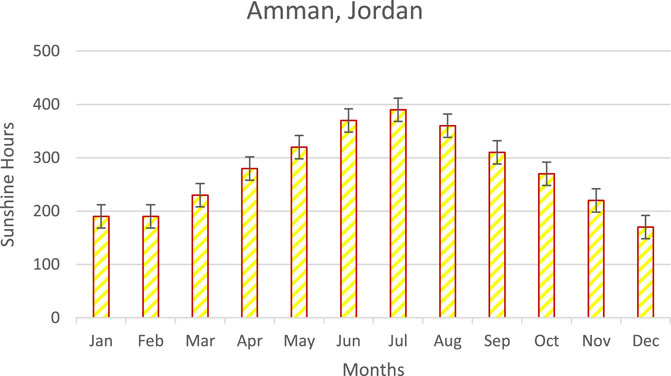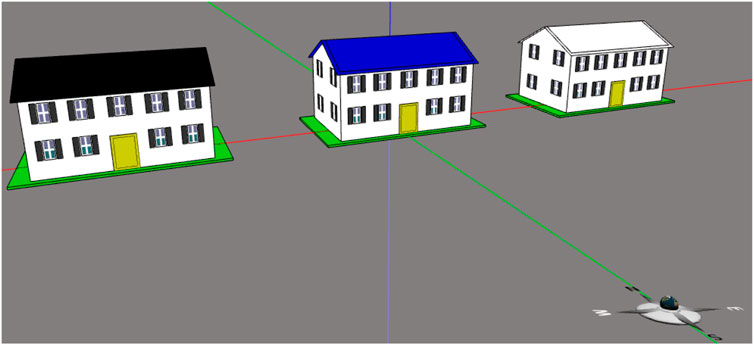- 1Mechanical Engineering Department, Faculty of Engineering, Mutah University, Al-Karak, Jordan
- 2Materials Science and Energy Lab, MSEL. Mutah University, Al-Karak, Jordan
- 3Department of Architecture Engineering, Faculty of Engineering, Mutah University, Al-Karak, Jordan
Energy consumption in the buildings sector is considered one of the most important sources of energy consumption in Jordan, as the reason for this is due to the traditional building pattern and the buildings’ lack of various energy saving and rationalization systems. The development of the buildings sector in terms of the capacity of buildings to save and produce energy is one of the most important reasons that lead to saving energy consumption at the national level in Jordan. In this study, the effect of paint colors on the roofs of buildings was studied by studying three different colors, which are blue, white, and black, where it was confirmed that the best colors in energy conservation is black, and white is the opposite of it, which is considered the worst in energy conservation.
Introduction
Buildings of different types, residential and commercial, constitute a large part of the causes of energy consumption for various purposes. Hence, interest in building technology has emerged so that buildings are environmentally friendly so that they use the least amount of energy for various internal purposes (Alrwashdeh, 2017; Alrwashdeh, 2018a; Al-Falahat et al., 2019; Al-Falahat et al., 2022a; Abu Qadourah et al., 2022; Al-Falahat et al., 2022b). Energy is used in buildings for many purposes, including cooling, heating, and completing the basic operations of life, such as heating water, cooking, etc. (Alrwashdeh, 2018b; Alrwashdeh, 2018c; Alrwashdeh, 2018d; Alrwashdeh, 2018e; S. Alrwashdeh, 2018; Alrwashdeh, 2018f; Alrwashdeh, 2018g). It is necessary to find the most appropriate ways to try to rationalize energy consumption for those uses and trying to secure what is possible from this need for energy from natural sources (Kong and He, 2021; Windapo et al., 2021; Sandberg et al., 2021; Alrwashdeh, 2019a; S. Alrwashdeh, 2019; Alrwashdeh, 2019b; Alrwashdeh, 2021; Alrwashdeh, 2022).
Numerous studies on buildings have been employed to study ways to save energy, and many studies have emerged concerned with wall insulation technology, such as insulation by rock wool, insulation by foam, insulation by polystyrene, and natural insulation with air (Cui and Overend, 2019; Favoino et al., 2017; Cuce, 2016; Alrwashdeh and Alsaraireh, 2018; S. Alrwashdeh et al., 2018; Alrwashdeh and Ammari, 2019; Alrwashdeh et al., 2022; Alrwashdeh et al., 2017a). Other studies have focused on developing building windows through the use of double and triple glazing, and some studies have gone into window frames and the types of materials that can be used to manufacture window frames, such as wood, aluminum, and other materials (Tsagarakis et al., 2012; Ammari et al., 2015; Cuce and Riffat, 2015; Alrwashdeh et al., 2016a; Alrwashdeh et al., 2016b; Alrwashdeh et al., 2017b; Alrwashdeh et al., 2017c; Aburas et al., 2019; Altarawneh et al., 2022). Studies have also emerged about the doors used in buildings, and today, there are wooden and iron doors and others (Mahajan et al., 2015; Sun et al., 2016; Saraireh et al., 2017; Sun et al., 2017; Göbel et al., 2018; Ince et al., 2018; Markötter et al., 2019; Henman et al., 2021; Hsu et al., 2021). In another framework, concerned with the different uses of energy inside buildings, the use of energy-saving technologies has emerged in recent times significantly. The interest of researchers and scholars in the characteristics of buildings exceeded the traditional thinking, but they are thinking about the advanced technology and its use to save energy in today’s buildings. Examples are multiple, such as the use of nanotechnology and the use of renewable energy sources (Hossain, 2018; Buttitta et al., 2021; Kardani et al., 2021; Sandberg et al., 2021; Taveres-Cachat et al., 2021).
Renewable energy is used for several purposes inside buildings, including heating water, natural lighting, generating electrical energy for various purposes in buildings, and other uses (Alrwashdeh, 2018a; Alrwashdeh, 2018b; Alrwashdeh, 2018d; Alrwashdeh, 2018e; S. Alrwashdeh, 2018; Alrwashdeh, 2018g; Alrwashdeh, 2019a; S. Alrwashdeh, 2019; Alrwashdeh, 2019b; Alrwashdeh and Alsaraireh, 2018). Photovoltaic cells are used for the purposes of generating electrical energy directly from solar energy for buildings, and this technology is today the most popular technology for the energy security of buildings. From here, buildings can be classified into several types according to energy-saving self-reliance (Alrwashdeh, 2017; Alrwashdeh, 2018a; Alrwashdeh, 2018b; Alrwashdeh, 2018c; Alrwashdeh, 2018d; Alrwashdeh, 2018e; S. Alrwashdeh, 2018; Alrwashdeh, 2018g; Alrwashdeh, 2019a; S. Alrwashdeh, 2019; Alrwashdeh, 2019b; Alrwashdeh and Alsaraireh, 2018). Among these classifications are low-carbon buildings, zero-energy buildings, and energy-surplus buildings. One of the problems facing energy-saving technology during construction is the high cost of employing these technologies during construction. However, the development of technology and its progress, and these days the costs have become reasonable and acceptable, and these technologies have begun to be widely used in construction in various countries of the world (Lin et al., 2020; Hoffmann et al., 2021; Lu et al., 2021; Xiong and Hu, 2021; Yi et al., 2021; Zhang et al., 2021).
The use of technology was not limited to methods of generating the energy required for buildings but went beyond that to transforming buildings into smart buildings that respond to various variables that lead to energy consumption. Energy recycling systems and the use of large fractions of waste energy have become today a widely used phenomenon and help in saving energy very greatly (Aburas et al., 2019; Lin et al., 2020).
Paints can affect solar radiation absorption dynamically depending on the colors: Reflecting more solar radiation by the lighter color ranges, and on the other hand, absorping more solar radiation by the dark color ranges. Therefore, the studying of buildings colors can contribute to lowering both cooling and heating loads of the buildings (Santamouris et al., 2011). Several studies have addressed the effect of coloring paints on buildings. Karlessi et al. developed dye-based coatings in several colors and tested their properties. They found that the reflectance of solar radiation increased by 4%–43% from colored to colorless. Zhang et al. studied the effects of the TiO2 particle size on the spectrum reflection of the paints. It is found that the larger TiO2 particle size leads to higher reflectivity and the maximum change in solar reflectance can reach 0.22 (Zhang and Zhai, 2019). Several simulation works have been conducted to investigate the energy-saving potential by using different engineering technology (Al-Falahat et al., 2019; Alrwashdeh, 2017; Alrwashdeh, 2018a; Alrwashdeh, 2018b; Alrwashdeh, 2018c; Alrwashdeh, 2018d; Alrwashdeh, 2018e; S. Alrwashdeh, 2018; Alrwashdeh, 2018f; Alrwashdeh, 2018g; Alrwashdeh, 2019a; S. Alrwashdeh, 2019; Alrwashdeh, 2019b; Alrwashdeh and Alsaraireh, 2018; S. Alrwashdeh et al., 2018; Alrwashdeh and Ammari, 2019; Alrwashdeh et al., 2017a; Alrwashdeh et al., 2017b; Alrwashdeh et al., 2017c; Alrwashdeh et al., 2016a; Alrwashdeh et al., 2016b; Ammari et al., 2015; Göbel et al., 2018; Ince et al., 2018; Markötter et al., 2019; Saraireh et al., 2017; Sun et al., 2017; Sun et al., 2016). Zheng et al. constructed a room as a model and simulated the performance of energy by using yellow paint in some cities of China. The results illustrate that for the cities with a wide range seasonal climate differences, coatings perform better in reducing building energy consumption (Zheng et al., 2015).
In this study, the focus was on the color of the external roof of the buildings with the aim of studying the best colors that would help in obtaining the largest possible amount of energy, which is thus considered a way to help reduce the necessary loads of energy for buildings where the use of white, black, and blue colors was studied.
Geographical and Meteorological Data
Amman is the capital of Jordan and is located in the center of Jordan within a longitude and latitude 36° east and 32° to the north, respectively. Amman is considered one of the sunniest cities, where the number of hours of solar radiation in Amman is about 3300 h/year, and this is one of the highest rates in the world, as shown in Figure 1.
Figure 2 indicates the average temperature in the Jordanian capital Amman throughout the year, with its upper and lower limits, as it is noted that the highest temperatures were recorded in the months June, July, August, and September, while the lowest temperatures were recorded during the months January, February, and December.
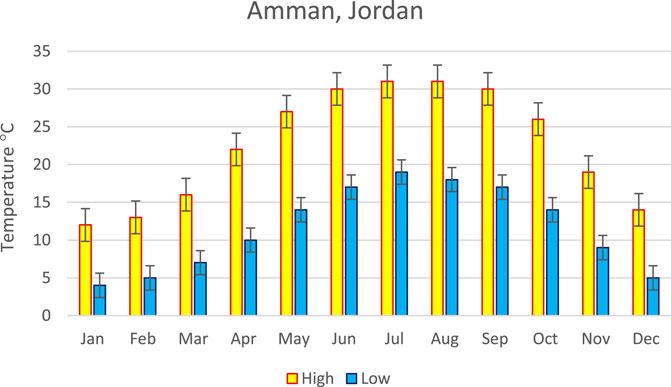
FIGURE 2. The average temperature in the Jordanian capital Amman throughout the year, with its upper and lower limits.
Solar Calculations
Solar radiation calculations are one of the complex engineering calculations for the large number of factors involved in the various calculations. In this paper, some calculations related to solar radiation will be listed as a way to interpret the scientific results of the research.
Solar radiation in Jordan is considered one of the highest in the world, as the daily average solar radiation in Amman is about 4–8 kWh/m2, and that represented annually with an amount of 1400–2300 kWh/m2. This makes solar energy the future hope in order to provide a large part of the energy needs in Jordan. Based on the intensity of solar radiation in Jordan, it has been divided into five regions according to the strength of solar radiation, which are the southern region, the eastern region, the central region, the northern region, and finally the western region, with a solar radiation rate of 6–7, 5.5–6, 4.5–5, 5.5, and below 4.5 kWh/m2, respectively (Alrwashdeh and Saraireh, 2018).
The angular position of the sun at solar noon, with respect to the plane of the equator with a value in degrees, is called the solar declination. It is given through the the following formula:
where n represents the day of the year. Thus, the first day of the first month of the year is number one, and the days followed by counting in series so that the last day of the year in the last month is day number 365.
The sun angular displacement east or west related to the local meridian, as negative in the morning and positive during the afternoon are called the Solar Hour Angle (SHA), i.e., SHA is 0.0 at solar noon and changed by a value of 15° per solar noon hour.
The symmetric solar hour angle with respect to the time during the sunset is called the sunset hour angle ws. It is given through the following formula:
where δ is the declination and ϕ is the latitude of the site.
Solar radiation outside the atmosphere is called extraterrestrial radiation. The daily extraterrestrial solar radiation at the horizontal surface can be calculated by using the the following formula:
where Gsc is the solar constant and equal to 1367 W/m2.
It is important to know that not all the solar radiation coming out of the sun reaches the atmosphere and not all the radiation that reaches the atmosphere reaches the earth, and even the radiation that reaches the earth arrives in different forms and types due to the weather factors and conditions facing the rays.
Results and Discussion
Solar radiation is the energy of radiation reaching the surface of the earth, and it is measured in Wh/m2. Calculations related to solar radiation are made based on the value of daily radiation in relation to the month in which the calculations are to be made. Figure 3 shows a scheme of three geometrically identical houses that differ only in the paint color of their exterior surfaces, where the colors white, blue, and black were used to study the effect of paint color on the amount of energy gained, thus studying the possibility of saving energy.
The tenth of December is the worst day in the solar radiation in Jordan and in Amman, the capital of Jordan, where the number of sunshine hours is only 6 h. Figure 4 shows the amount of energy loss in the three houses used to study with the different colors of the roofs, where Figure 4A shows the three buildings and the thermal form of energy and Figure 4B shows the amount of energy wasted in buildings with different colors, where it was found from these results that the building with a black roof has energy losses at a rate of −0.93 kWh, followed by the building with a blue roof color with losses rate of −2.73 kWh, and the most energy-wasting was in the building with white roof at a rate of −5.42 kWh.
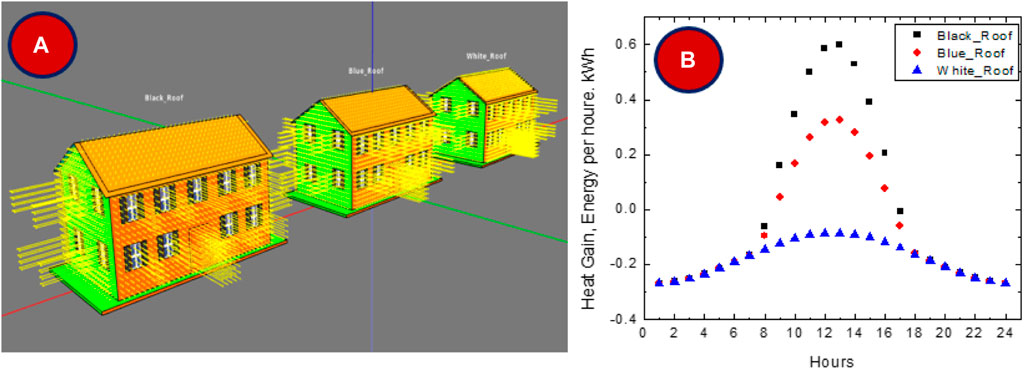
FIGURE 4. Energy form of the three buildings (A) and energy loss rate of the three buildings during 10th of December (B).
Figure 5 shows the thermal diagram of the energy in the three buildings studied with the different colors white, blue, and black. The building has a black roof color and is located on the left of the image; the building has a white roof color and is located to the right of the image; and the building has a blue roof color and is located in the middle. It appears from the figure that the building with the black roof color has the ability to gain energy from the sun more than all the buildings studied. Followed by the blue roof color, the worst of them all is the building with the white roof color. The idea behind the ability of the black color to gain more energy is the ability to absorb the sun rays falling on the roof painted with black.
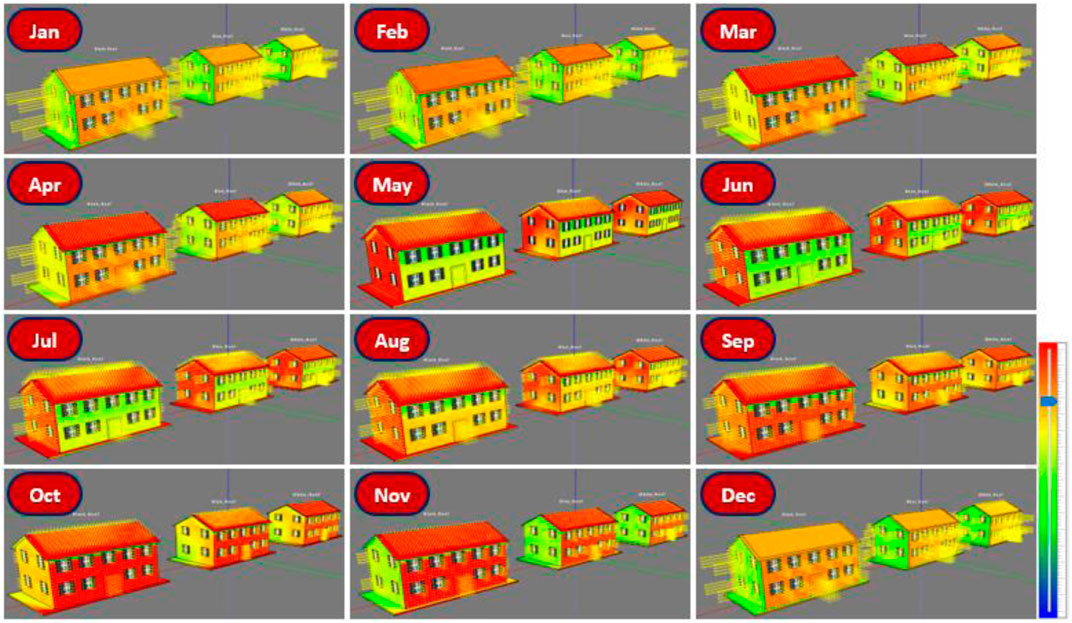
FIGURE 5. The three buildings with the different roof colors’ energy gain map from January till December.
Figure 6 shows the average energy consumption in the study buildings for heating and cooling purposes with an average monthly rate of 1487 kWh, where it is clear from Figure 6A that the energy consumption from June till October was for cooling purposes only and for the rest of the year between cooling and heating as for heating, the need for it appears within January, February, and December completely and rest of the year, at different rates. Figure 6B shows the rate of energy gain throughout the year for the buildings, the purpose of the study, with different surface colors of black, blue, and white, it was found that the building with the color of the black roof was the best buildings to gain energy at a rate of 3187 kWh per year, followed by the building with the blue roof color at a rate of 1745 kWh, while the worst building in gaining energy was the building with white roof color with a rate of −414 kWh.
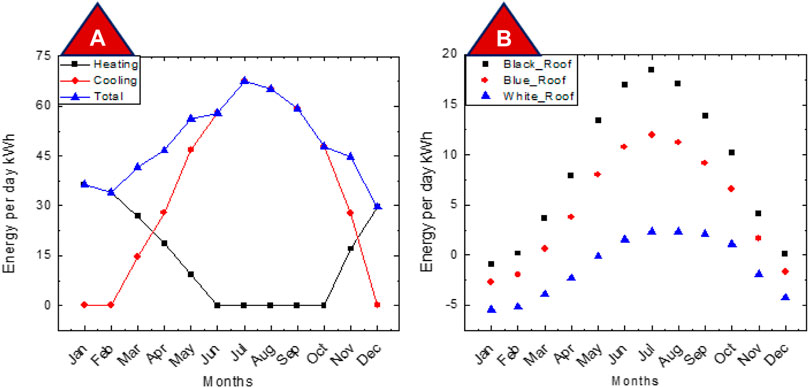
FIGURE 6. Energy consumption for heating and cooling (A) and energy gain from the buildings’ roof with different colors (B).
Conclusion
The study was based on analyzing the climatic conditions of the target area, which is the Jordanian capital—Amman. Jordan is one of the solar belt countries, which enjoys a very high solar radiation rate, making it one of the highest in the world in solar energy. The effect of the different paint colors for the surface of the building chosen for the study was studied, and the study colors were blue, white, and black, as each case was studied separately and the effect of paint on energy acquisition and conservation was studied. It was found that the black color is the best in the process of energy conservation for its high ability to absorb the rays falling on it. In contrast, it was found that the white color is the worst in energy conservation, and the blue color came as an intermediate state between the two colors white and black.
The study adopts the experimental approach, which aims to highlight the energy problems and try to propose solutions to bridge the energy deficit, especially since Jordan is one of the countries that suffers from energy problems that dominate the world greatly these days, and from here, it is recommended to develop special building codes that help and encourage ways to rationalize energy consumption and develop the idea of energy-producing buildings.
Data Availability Statement
The raw data supporting the conclusions of this article will be made available by the authors, without undue reservation.
Author Contributions
All authors listed have made a substantial, direct, and intellectual contribution to the work and approved it for publication.
Conflict of Interest
The authors declare that the research was conducted in the absence of any commercial or financial relationships that could be construed as a potential conflict of interest.
Publisher’s Note
All claims expressed in this article are solely those of the authors and do not necessarily represent those of their affiliated organizations, or those of the publisher, the editors, and the reviewers. Any product that may be evaluated in this article, or claim that may be made by its manufacturer, is not guaranteed or endorsed by the publisher.
References
Abu Qadourah, J., Al-Falahat, A. M., Alrwashdeh, S. S., and Nytsch‐Geusen, C. (2022). Improving the Energy Performance of the Typical Multi-Family Buildings in Amman, Jordan. City, Territ. Archit. 9 (1). doi:10.1186/s40410-022-00151-8
Aburas, M., Soebarto, V., Williamson, T., Liang, R., Ebendorff-Heidepriem, H., and Wu, Y. (2019). Thermochromic Smart Window Technologies for Building Application: A Review. Appl. Energy 255, 113522. doi:10.1016/j.apenergy.2019.113522
Al-Falahat, A. a., Abu, Q., and Alrwashdeh, S. (2022). Economic Feasibility of Heating Source Conversion of the Swimming Pools. J Appl Eng Sci. 20 (1), 230–238. doi:10.5937/jaes0-34474
Al-Falahat, A. M., Kardjilova, N., Khanha, T. V., Marköttera, H., Boina, M., Woracek, R., et al. (2019). Energy-selective Neutron Imaging by Exploiting Wavelength Gradients of Double Crystal Monochromators—Simulations and Experiments. Nucl. Instrum. Methods Phys. Res. Sect. A Accel. Spectrom. Detect. Assoc. Equip. 943, 943.
Al-Falahat, A. M., Qadourah, J. A., Alrwashdeh, S. S., khater, R., Qatlama, Z., Alddib, E., et al. (2022). Energy Performance and Economics Assessments of a Photovoltaic-Heat Pump System. Results Eng. 13.
Alrwashdeh, S. S., and Alsaraireh, F. M. (2018). Wind Energy Production Assessment at Different Sites in Jordan Using Probability Distribution Functions. ARPN J. Eng. Appl. Sci. 13 (20), 8163–8172.
Alrwashdeh, S. S., and Ammari, H. (2019). Life Cycle Cost Analysis of Two Different Refrigeration Systems Powered by Solar Energy. Case Stud. Therm. Eng. 16. doi:10.1016/j.csite.2019.100559
Alrwashdeh, S. S., Ammari, H., Madanat, M. A., Al-Falahat, A. M., and Al-Falahat, A. M. (2022). The Effect of Heat Exchanger Design on Heat Transfer Rate and Temperature Distribution. Emerg. Sci. J. 6 (1), 128–137. doi:10.28991/esj-2022-06-01-010
Alrwashdeh, S. S. (2019). An Energy Production Evaluation from PV Arrays with Different Inter-row Distances. Int. J. Mech. Prod. Eng. Res. Dev. 9 (5), 1–10. doi:10.24247/ijmperdapr201945
Alrwashdeh, S. S. (2018). Assessment of Photovoltaic Energy Production at Different Locations in Jordan. Int. J. Renew. Energy Res. 8 (2), 797–804.
Alrwashdeh, S. S. (2018). Assessment of the Energy Production from PV Racks Based on Using Different Solar Canopy Form Factors in Amman-Jordan. Int. J. Eng. Res. Technol. 11 (10), 1595–1603.
Alrwashdeh, S. S. (2018). Comparison Among Solar Panel Arrays Production with a Different Operating Temperatures in Amman-Jordan. Int. J. Mech. Eng. Technol. 9 (6), 420–429.
Alrwashdeh, S. S. (2017). Determining the Optimum Tilt Solar Angle of a PV Applications at Different Sites in Jordan. J. Eng. Appl. Sci. 12 (Specialissue11), 9295–9303.
Alrwashdeh, S. S. (2018). Energy Production Evaluation from a Linear Fresnel Reflectors Arrays with Different Array Orientation. Int. J. Eng. Res. Technol. 11 (11), 1811–1819.
Alrwashdeh, S. S. (2021). Investigation of the Energy Output from PV Panels Based on Using Different Orientation Systems in Amman-Jordan. Case Stud. Therm. Eng. 28. doi:10.1016/j.csite.2021.101580
Alrwashdeh, S. S. (2018). Investigation of the Energy Output from PV Racks Based on Using Different Tracking Systems in Amman-Jordan. Int. J. Mech. Eng. Technol. 9 (10), 687–694.
Alrwashdeh, S. S. (2019). Investigation of Wind Energy Production at Different Sites in Jordan Using the Site Effectiveness Method. Energy Eng. 116 (1), 47–59. doi:10.1080/01998595.2019.12043338
Alrwashdeh, S. S., Manke, I., Markötter, H., Haußmann, J., Arlt, T., Hilger, A., et al. (2017). Improved Performance of Polymer Electrolyte Membrane Fuel Cells with Modified Microporous Layer Structures. Energy Technol. 5 (9), 1612–1618. doi:10.1002/ente.201700005
Alrwashdeh, S. S., Manke, I., Markötter, H., Haußmann, J., Kardjilov, N., Hilger, A., et al. (2017). Neutron Radiographic in Operando Investigation of Water Transport in Polymer Electrolyte Membrane Fuel Cells with Channel Barriers. Energy Convers. Manag. 148, 604–610. doi:10.1016/j.enconman.2017.06.032
Alrwashdeh, S. S., Manke, I., Markötter, H., Klages, M., Göbel, M., Haußmann, J., et al. (2017). In Operando Quantification of Three-Dimensional Water Distribution in Nanoporous Carbon-Based Layers in Polymer Electrolyte Membrane Fuel Cells. ACS Nano 11 (6), 5944–5949. doi:10.1021/acsnano.7b01720
Alrwashdeh, S. S., Markötter, H., Haußmann, J., Scholta, J., Hilger, A., and Manke, I.,. X-ray Tomographic Investigation of Water Distribution in Polymer Electrolyte Membrane Fuel Cells with Different Gas Diffusion Media. 2016. In. 229th ECS MEETING. May 29-June 2, 2016, San Diego, CA.doi:10.1149/ma2016-01/1/101
Alrwashdeh, S. S., Markötter, H., Haußmann, J., Arlt, T., Klages, M., Scholta, J., et al. (2016). Investigation of Water Transport Dynamics in Polymer Electrolyte Membrane Fuel Cells Based on High Porous Micro Porous Layers. Energy 102, 161–165. doi:10.1016/j.energy.2016.02.075
Alrwashdeh, S. S. (2018). Modelling of Operating Conditions of Conduction Heat Transfer Mode Using Energy 2D Simulation. Int. J. Online Eng. 14 (9), 200–207. doi:10.3991/ijoe.v14i09.9116
Alrwashdeh, S. S. (2018). Predicting of Energy Production of Solar Tower Based on the Study of the Cosine Efficiency and the Field Layout of Heliostats. Int. J. Mech. Eng. Technol. 9 (11), 250–257.
Alrwashdeh, S. S., and Saraireh, M. A. (2018). Solar Radiation Map of Jordan Governorates. Int. J. Eng. Technol. (UAE) 7 (3), 1664–1667.
Altarawneh, O. R., Alsarayreh, A. A., Al-Falahat, A. M., Al-Kheetan, M. J., and Alrwashdeh, S. S. (2022). Energy and Exergy Analyses for a Combined Cycle Power Plant in Jordan. Case Stud. Therm. Eng. 31, 31. doi:10.1016/j.csite.2022.101852
Ammari, H. D., Al-Rwashdeh, S. S., and Al-Najideen, M. I. (2015). Evaluation of Wind Energy Potential and Electricity Generation at Five Locations in Jordan. Sustain. Cities Soc. 15, 135–143. doi:10.1016/j.scs.2014.11.005
Buttitta, G., Jones, C. N., and Finn, D. P. (2021). Evaluation of Advanced Control Strategies of Electric Thermal Storage Systems in Residential Building Stock. Util. Policy 69, 101178.
Cuce, E., and Riffat, S. B. (2015). Vacuum Tube Window Technology for Highly Insulating Building Fabric: An Experimental and Numerical Investigation. Vacuum 111, 83–91. doi:10.1016/j.vacuum.2014.10.002
Cuce, E. (2016). Toward Multi-Functional PV Glazing Technologies in Low/zero Carbon Buildings: Heat Insulation Solar Glass - Latest Developments and Future Prospects. Renew. Sustain. Energy Rev. 60, 1286–1301. doi:10.1016/j.rser.2016.03.009
Cui, H., and Overend, M. (2019). A Review of Heat Transfer Characteristics of Switchable Insulation Technologies for Thermally Adaptive Building Envelopes. Energy Build. 199, 427–444. doi:10.1016/j.enbuild.2019.07.004
Favoino, F., Jin, Q., and Overend, M. (2017). Design and Control Optimisation of Adaptive Insulation Systems for Office Buildings. Part 1: Adaptive Technologies and Simulation Framework. Energy 127, 301–309. doi:10.1016/j.energy.2017.03.083
Göbel, M., Kirsch, S., Schwarze, L., Schmidt, L., Scholz, H., Haußmann, J., et al. (2018). Transient Limiting Current Measurements for Characterization of Gas Diffusion Layers. J. Power Sources 402, 237–245.
Henman, P., Graham, T., and Lata, L. N. (2021). Building the 'front Door' within a Web Ecology: Informational Governance and Institutional Shaping of National Government Webportals. Gov. Inf. Q. 38 (2), 101575. doi:10.1016/j.giq.2021.101575
Hoffmann, K. A., Šuklje, T., Kozamernik, J., and Nehls, T. (2021). Modelling the Cooling Energy Saving Potential of Facade Greening in Summer for a Set of Building Typologies in Mid-latitudes. Energy Build. 238, 110816.
Hossain, M. F. (2018). Green Science: Advanced Building Design Technology to Mitigate Energy and Environment. Renew. Sustain. Energy Rev. 81, 3051–3060. doi:10.1016/j.rser.2017.08.064
Hsu, Y.-S., Zheng, X., Cooper, E., Gillott, M., and Wood, C. J. (2021). Evaluation of the Indoor Pressure Distribution during Building Airtightness Tests Using the Pulse and Blower Door Methods. Build. Environ. 195, 107742.
Ince, U. U., Markötter, H., George, M. G., Liu, H., Ge, N., Lee, J., et al. (2018). Effects of Compression on Water Distribution in Gas Diffusion Layer Materials of PEMFC in a Point Injection Device by Means of Synchrotron X-Ray Imaging. Int. J. Hydrogen Energy 43 (1), 391–406. doi:10.1016/j.ijhydene.2017.11.047
Kardani, N., Bardhan, A., Kim, D., Samui, P., and Zhou, A. (2021). Modelling the Energy Performance of Residential Buildings Using Advanced Computational Frameworks Based on RVM, GMDH, ANFIS-BBO and ANFIS-IPSO. J. Build. Eng. 35, 102105. doi:10.1016/j.jobe.2020.102105
Kong, F., and He, L. (2021). Impacts of Supply-Sided and Demand-Sided Policies on Innovation in Green Building Technologies: A Case Study of China. J. Clean. Prod. 294, 126279. doi:10.1016/j.jclepro.2021.126279
Lin, Y., Zhong, S., Yang, W., Hao, X., and Li, C.-Q. (2020). Towards Zero-Energy Buildings in China: A Systematic Literature Review. J. Clean. Prod. 276, 123297. doi:10.1016/j.jclepro.2020.123297
Lu, F., Yu, Z., Zou, Y., and Yang, X. (2021). Cooling System Energy Flexibility of a Nearly Zero-Energy Office Building Using Building Thermal Mass: Potential Evaluation and Parametric Analysis. Energy Build. 236, 110763. doi:10.1016/j.enbuild.2021.110763
Mahajan, G., Cho, H., Shanley, K., and Kang, D. (2015). Comprehensive Modeling of Airflow Rate through Automatic Doors for Low-Rise Buildings. Build. Environ. 87, 72–81. doi:10.1016/j.buildenv.2015.01.016
Markötter, H., Manke, I., Böll, J., Alrwashdeh, S., Hilger, A., Klages, M., et al. (2019). Morphology Correction Technique for Tomographic Iin-Ssitu and Operando Studies in Energy Research. J. Power Sources 414, 8–12.
S. Alrwashdeh, S., Alsaraireh, F. M., M. Alsaraireh, F., A. Saraireh, M., Markötter, H., Kardjilov, N., et al. (2018). In-situ Investigation of Water Distribution in Polymer Electrolyte Membrane Fuel Cells Using High-Resolution Neutron Tomography with 6.5 Μm Pixel Size. AIMS Energy 6 (4), 607–614. doi:10.3934/energy.2018.4.607
S. Alrwashdeh, S. (2019). Energy Production Assessment of Solar Tower Based on the Study of the Mirror Shadowing and Blocking Effects. ujme 7 (2), 71–76. doi:10.13189/ujme.2019.070205
S. Alrwashdeh, S. (2018). The Effect of Solar Tower Height on its Energy Output at Ma'an-Jordan. AIMS Energy 6 (6), 959–966. doi:10.3934/energy.2018.6.959
Sandberg, N. H., Næss, J. S., Brattebø, H., Andresen, I., and Gustavsen, A. (2021). Large Potentials for Energy Saving and Greenhouse Gas Emission Reductions from Large-Scale Deployment of Zero Emission Building Technologies in a National Building Stock. Energy Policy 152, 112114. doi:10.1016/j.enpol.2020.112114
Santamouris, M., Synnefa, A., and Karlessi, T. (2011). Using Advanced Cool Materials in the Urban Built Environment to Mitigate Heat Islands and Improve Thermal Comfort Conditions. Sol. Energy 85 (12), 3085–3102. doi:10.1016/j.solener.2010.12.023
Saraireh, M. A., Alsaraireh, F. M., and Alrwashdeh, S. S. (2017). Investigation of Heat Transfer for Staggered and In-Line Tubes. Int. J. Mech. Eng. Technol. 8 (11), 476–483.
Sun, F., Markötter, H., Manke, I., Hilger, A., Alrwashdeh, S. S., Kardjilov, N., et al. (2017). Complementary X-Ray and Neutron Radiography Study of the Initial Lithiation Process in Lithium-Ion Batteries Containing Silicon Electrodes. Appl. Surf. Sci. 399, 359–366. doi:10.1016/j.apsusc.2016.12.093
Sun, F., Markötter, H., Zhou, D., Alrwashdeh, S. S. S., Hilger, A., Kardjilov, N., et al. (2016). In Situ Radiographic Investigation of (De)Lithiation Mechanisms in a Tin-Electrode Lithium-Ion Battery. ChemSusChem 9 (9), 946–950. doi:10.1002/cssc.201600220
Taveres-Cachat, E., Favoino, F., Loonen, R., and Goia, F. (2021). Ten Questions Concerning Co-simulation for Performance Prediction of Advanced Building Envelopes. Build. Environ. 191, 107570. doi:10.1016/j.buildenv.2020.107570
Tsagarakis, K. P., Karyotakis, K., and Zografakis, N. (2012). Implementation Conditions for Energy Saving Technologies and Practices in Office Buildings: Part 2. Double Glazing Windows, Heating and Air-Conditioning. Renew. Sustain. Energy Rev. 16 (6), 3986–3998. doi:10.1016/j.rser.2012.03.007
Windapo, A., Omopariola, E. D., Olugboyega, O., and Moghayedi, A. (2021). Use and Performance of Conventional and Sustainable Building Technologies in Low-Income Housing. Sustain. Cities Soc. 65, 102606. doi:10.1016/j.scs.2020.102606
Xiong, W., and Hu, L. (Forthcoming 2021). Evaluation Method for Energy Saving Effect of Passive Ultra Low Energy Consumption Buildings Based on Fuzzy Grey Clustering Method. Microprocess. Microsystems, 104097. doi:10.1016/j.micpro.2021.104097
Yi, Z., Yingyan, I., Dikai, X., Jingtao, X., Hua, Q., Dongliang, Z., et al. (2021). Energy Saving Analysis of a Transparent Radiative Cooling Film for Buildings with Roof Glazing. Energy Built Environ. 2 (2), 214–222.
Zhang, S., Fu, Y., Yang, X., and Xu, W. (2021). Assessment of Mid-to-long Term Energy Saving Impacts of Nearly Zero Energy Building Incentive Policies in Cold Region of China. Energy Build. 241, 110938.
Zhang, Y., and Zhai, X. (2019). Preparation and Testing of Thermochromic Coatings for Buildings. Sol. Energy 191, 540–548. doi:10.1016/j.solener.2019.09.042
Keywords: solar energy, building sector, energy conservation, energy-consuming, energy gain
Citation: Alrwashdeh SS, Qadourah JA and Al-Falahat AM (2022) Investigation of the Effect of Roof Color on the Energy Use of a Selected House in Amman, Jordan. Front. Mech. Eng 8:897170. doi: 10.3389/fmech.2022.897170
Received: 15 March 2022; Accepted: 02 May 2022;
Published: 08 June 2022.
Edited by:
Fang Wang, Zhongyuan University of Technology, ChinaReviewed by:
Yuling Zhai, Kunming University of Science and Technology, ChinaJohn Banhart, Technical University of Berlin, Germany
Henning Markotter, Helmholtz Association of German Research Centers (HZ), Germany
Copyright © 2022 Alrwashdeh, Qadourah and Al-Falahat. This is an open-access article distributed under the terms of the Creative Commons Attribution License (CC BY). The use, distribution or reproduction in other forums is permitted, provided the original author(s) and the copyright owner(s) are credited and that the original publication in this journal is cited, in accordance with accepted academic practice. No use, distribution or reproduction is permitted which does not comply with these terms.
*Correspondence: Saad S. Alrwashdeh, c2FhZC5hbHJ3YXNoZGVoQG11dGFoLmVkdS5qbw==
 Saad S. Alrwashdeh
Saad S. Alrwashdeh Jenan Abu Qadourah3
Jenan Abu Qadourah3